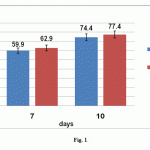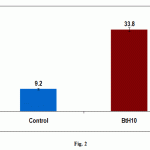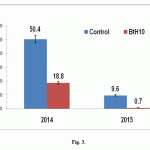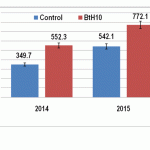How to Cite | Publication History | PlumX Article Matrix
Polyfunctional Properties Of The Entomopathogenic Bacterium In Protecting Potato In Western Siberia
P. Tsvetkova1, M. V. Shternshis1*, E. I. Shatalova1, S.A. Bakhvalov1, V. S. Maslennikova1 and S.D. Grishechkina2
1Novosibirsk State Agrarian University, 630039, Novosibirsk, Russia. 2All-Russian Institute of Agricultural Microbiology, 196608, St. Petersburg-Pushkin, Russia.
DOI : http://dx.doi.org/10.13005/bbra/1996
ABSTRACT: The Colorado potato beetle and the plant pathogen Rhizoctonia are the major harmful organisms affecting potatoes in Western Siberia. The present study has shown the possibility of simultaneous biological control of pests and diseases by preventing treatment of tubers with entomopathogenic bacterium Bacillus thuringiensis subsp. darmstadiensis (BtH10), strain RCAM 01490, followed by spraying with the same suspension during the growing season. The tests of middle-early cultivar “Yuna” were conducted under laboratory and field conditions during the course of two years. Population of the Colorado potato beetle has decreased by 3 times during both years in comparison with the control. The severity of stem canker decreased by 23.8 and 11.4 times, while stolon canker - by 2.6 and 12.4 times in 2014 and 2015, respectively. The growth-promoting action was manifested in increased height of plants, number of stems and stolons, as well as the increase in the proportion of large daughter tubers. As a result, the insecticidal, antifungal and growth-promoting cumulative effect of the entomopathogenic bacterium was revealed, resulting in higher biomass of potato daughter tubers, which exceeded biomass in control test by 1.4-1.6 times.
KEYWORDS: entomopathogenic bacterium; insecticidal and fungicidal activity; plant growth stimulation, potato; polyfunctional properties
Download this article as:| Copy the following to cite this article: Tsvetkova P, Shternshis M. V, Shatalova E. I, Bakhvalov S. A, Maslennikova V. S, Grishechkina S. D. Polyfunctional Properties Of The Entomopathogenic Bacterium In Protecting Potato In Western Siberia. Biosci Biotech Res Asia 2016;13(1) |
| Copy the following to cite this URL: Tsvetkova P, Shternshis M. V, Shatalova E. I, Bakhvalov S. A, Maslennikova V. S, Grishechkina S. D. Polyfunctional Properties Of The Entomopathogenic Bacterium In Protecting Potato In Western Siberia. Biosci Biotech Res Asia 2016;13(1). Available from: https://www.biotech-asia.org/?p=6888 |
Introduction
The Colorado potato beetle (Leptinotarsa decemlineata Say) and phytopathogenic fungus (Rhizoctonia solani Kuhn.) are the main pests that damage potato (Solanum tuberosum L.) in Western Siberia. The Colorado potato beetle is the main potato phytophage worldwide1. In Western Siberia, it appeared much later, from the end of the XX – beginning of the XXI century and quickly became the most dangerous phytophage over the short time period. It is known that the chemical insecticides were the first most effective means to control the Colorado potato beetle2. However, studies carried out in various countries revealed gradually acquired resistance of this insect towards chemical insecticides3,4. Besides, the adverse effects of chemicals on the environment and human health are well known5,6. This has led to the search for alternative environmentally safe methods to control the population of the Colorado potato beetle7-9. The use of natural biological agents of bacterial and fungal origin seems to be the most attractive means. Thus, as early as in the middle of the XX century it was proposed to suppress the population of the beetle larvae by spraying potato plants with fungi Beauveria bassiana Bals. Vuil10,11 and later with Metarhizium spp.12,13. Compared to fungus-based formulations, the Russian Bitoxibacillin preparation, based on exotoxin-containing strain Bacillus thuringiensis subsp. thuringiensis, turned out to be more effective14. In addition, in 1983, a new subspecies of Bacillus thuringiensis subsp. tenebrionis15 were isolated and identified, which was specific against the Colorado potato beetle and served as the basis for the development of biological preparations.
Table 1. Biological efficacy of BtH10 against the Colorado potato beetle larvae in laboratory experiment
| Larval instar | Biological efficacy at daily accounting, % | |||
| 3 | 5 | 7 | 10 | |
| L1 | 80.0 | 96.7 | 100.0 | 100.0 |
| L2 | 66.7 | 93.3 | 93.3 | 100,0 |
| L3 | 30.0 | 35.7 | 36.9 | 58.8 |
| L4 | 10.0 | 11.5 | 16.1 | 34.5 |
Along with the Colorado potato beetle, a serious problem in West Siberia is Rhizoctonia disease of potato. To control disease caused by phytopathogenic fungus Rhizoctonia solani Kuhn., the main method of potato protection in West Siberia, like in other geographical regions of the world, is the application of chemical fungicides. However, a growing body of research is currently focused on the development of microbiological methods for protection against Rhizoctonia disease16-18.
At present time, the biological preparations not always are competitive with chemical pesticides, and one of the reasons is the high selectivity of the biological control agent, forcing the use of two or more biological preparations instead of one chemical pesticide. To improve competitiveness it is desirable to use biological preparations of polyfunctional action, possessing, for example, both insecticidal and fungicidal properties.
Table 2. Influence of BtH10 on disease severity and incidence of potato stem canker and stolon canker, %
|
Weeks after planting |
Test variants |
Average score of the stems lesion | Disease severity on stems, % | Disease incidence on stolons, % | |||
| 2014 | 2015 | 2014 | 2015 | 2014 | 2015 | ||
|
6 |
Control | 0.5 | 0.68 | 12.6 | 13.3 | 18.2 | 9.5 |
| BtH10 | 0.1 | 0.08 | 1.9 | 1.5 | 9.1 | 0 | |
|
10 |
Control | 1.5 | 0.44 | 59.6 | 40.0 | 36.0 | 28.6 |
| BtH10 | 0.1 | 0.16 | 2.5 | 3.5 | 13.8 | 2.3 | |
| НСР05 | 0.25 | 0.30 | 4.0 | 3.3 | |||
The biological agents of such effect include bacteria of the genus Bacillus: B. subtilis19, 20 or B.thuringiensis21-24. Previously, it was shown that strain B. thuringiensis ssp. darmstadiensis (BtH10), isolated from the Colorado potato beetle, exhibited insecticidal activity against the Colorado potato beetle of northwest and south populations25. In addition, this strain has shown antifungal activity against Rhizoctonia disease of potato at a single treatment of potato tubers when planting “Lubava” and “Lugovskoy” potato cultivars26. However, it is important to reveal the dual effect of this bacterium, supplementing the treatment of tubers before planting by spraying with a bacterial suspension during the growing season. Due to the fact that early potato “Yuna” is a promising cultivar for Western Siberia region, it was challenging to use it for carrying out the study on the polyfunctional properties of the entomopathogenic bacterium.
Table 3. Growth-promoting action of strain BtH10 at potato protection
|
Treatment |
Year |
Plants height, cm | Number of stems | Number of stolons | ||||||
| Weekly accounting | ||||||||||
| 4 | 6 | 10 | 4 | 6 | 10 | 4 | 6 | 10 | ||
| Control | 2014 | 8.2 | 20.0 | 41.2 | 2.5 | 3.1 | 3.1 | 2 | 11 | 25 |
| 2015 | 11.6 | 31.0 | 31.2 | 3.0 | 3.4 | 3.4 | 3 | 21 | 21 | |
| BtH10 | 2014 | 11.3 | 22.7 | 48.3 | 3.1 | 3.9 | 4.2 | 3 | 16 | 29 |
| 2015 | 13.9 | 37.1 | 40.8 | 4.2 | 5.0 | 5.2 | 4 | 40 | 42 | |
|
НСР05 |
through 2014 – 3.4
through 2015 – 4.2 |
through 2014 – 0.6
through 2015 – 0.9 |
through 2014 – 3.6
through 2015 – 4.9 |
|||||||
The objective of the present work consisted in evaluation of the insecticidal, antifungal and growth-promoting action of B. thuringiensis subsp. darmstadiensis at treatment of the potato tubers before planting followed by subsequent spraying during the growing season under the natural conditions of Western Siberia.
Materials And Methods
The research objects were the plants of “Yuna” potato cultivar, the Colorado potato beetle, Rhizoctonia disease of potato, Bacillus thuringiensis ssp. darmstadiensis (BtH10), the strain RCAM 01490 taken from the collection of the All-Russian Institute for Agricultural Microbiology.
The efficacy of the bacterial strain against the Colorado potato beetle in a laboratory experiment was tested on larvae of all instars, taken from natural populations. Larvae were planted on the leaves of “Yuna” potato cultivar in Petri dishes and sprayed with a bacterial suspension (106 CFU/ml). The leaves were substituted while drying. Larval mortality was estimated on the 3rd, 5th, 7th and 10th day. Biological efficacy was calculated by the Abbot formula.
Field experiments were conducted on potato experimental plots, located in the Novosibirsk District of the Novosibirsk Region (5501´N, 82055´E). The experiments were performed in three replicates; the area of each plot was 30 m2 and included 360 plants (70х35 cm planting system). The vegetation period in 2014 was characterized as arid, while in 2015 – as humid.
Field experiments included 2 variants in three replications: 1) control (without treatment); 2) treatment of tubers with BtH10, followed by spraying during the growing season with bacterial suspension (106 CFU/ml). The mortality of the Colorado potato beetle larvae was checked 7 and 10 days after spraying the plants.
Table 4. Influence of BtH10 on fractional composition of daughter tubers
| Treatment |
Year |
Fractional composition of tubers, % | ||
| Small fraction | Medium fraction | Large fraction | ||
| Control | 2014 | 4.8 | 34.9 | 60.3 |
| 2015 | 13.1 | 63.7 | 23.2 | |
| BtH10 | 2014 | 1.2 | 16.2 | 82.2 |
| 2015 | 6.1 | 45.9 | 48.0 | |
The potato stem canker and stolon canker were evaluated 6 and 10 weeks after planting. Disease severity was determined on a Frank scale27, calculating the disease incidence (P) and disease severity (R) by the formulas: P = R×100/N ,where R – is the number of diseased plants, N – is the total number of record plants; R= ∑(a×b)×100/N×K , where ∑(a×b)– is the sum of the products of the number of diseased plants (a) over the score of the lesion (b), where N – is the total number of record plants, K – is the highest score of the accounting scale. Six weeks after potato planting, samples of potato leaves were collected from the control and experimental sites to determine the peroxidase activity 28.
The degree of black scurf of the daughter tubers was estimated by the ratio of the mass fraction of healthy and diseased tubers29. Fractional composition of tubers was determined by weighing. Depending on mass, tubers were grouped into 3 fractions: small fraction – up to 35 grams, medium fraction – from 35 to 80 grams, and large fraction – over 80 grams. Growth rate and development of plants were monitored during the growing season. The effect of BtH10 on plant height, number of stems and stolons, as well as tubers mass was evaluated during the experiments.
Statistical data processing was performed by standard methods using MS Excel and ANOVA program for Windows. Data were compared by calculating LSD05 (Least Significant Difference).
Results And Discussion
The mortality of 1st and 2nd– instar larvae under the action of BtH10 in laboratory occurred on the 1st day, while on the 5th day reached 100%, significantly differing from larval mortality in the control (p<0.05). Since older larvae are more resistant to bacteria, their mortality, checked on the 10th day, was by 2.6 and 1.6 times less as compared to younger instar larvae (p<0.05) (Table 1). Such dependence is typical for populations of the Colorado potato beetle in different geographic regions under the action of different B. thuringiensis subspecies.
During two years of research in the field environment, the mortality of the Colorado potato beetle larvae was not less than 60% seven days after spraying bacterial suspension, and at least 70% ten days after spraying (Fig. 1).
 |
Figure 1: Biocontrol efficacy (%) of BtH10 towards the Colorado beetle larvae in the field. |
At the same time bacterial strain BtH10 at the initial treatment of planting material and subsequent spraying of plants during the growing season caused a significant reduction in the infestation of potato stems and stolons by pathogen Rhizoctonia (Table 2). Thus, in 2014 the average score of infestation by stem canker statistically significantly (p<0.05) decreased by 5-15 times in 6-10 weeks, while in 2015 – by 8.7-2.7 times in comparison to the control. Disease severity on the stems also decreased on average during two years by 9.4-16.6 times over concerned periods. Comparing the data obtained during treatment the tubers of early potato cultivar in 2014 with just the same bacterial suspension without spraying26, it can be stated that the impact of additional spraying during the growing season on Rhizoctonia disease severity is much higher.
Induction of resistance in potato plants under the influence of entomopathogenic bacterium was confirmed by measurement of the peroxidase activity in potato leaves sampled from control and treated plants (Fig. 2).
 |
Figure 2: Peroxidase activity in potato leaves under the influence of BtH10 six weeks after planting. |
Application of BtH10 by described two techniques provided also a reduction in the disease incidence on daughter tubers by 2.9 times in 2014 and has led to almost complete release from the disease in 2015 (Fig. 3).
 |
Figure3: Disease incidence (%) on the daughter tubers under the influence of BtH10 treatment. |
In addition to insecticidal and antifungal activity of bacteria, we revealed also its growth-promoting action on potato. In a field experiment, potato plants have formed bushes faster under the influence of BtH10. In 2015, statistically significant increase (p<0.05) of potato plant height in comparison to control was observed 6 and 10 weeks after planting, while in 2014 a significant increase in the height was observed 10 weeks after planting. In both studied years, statistically significant increase (p<0.05) in the number of stems in the bush exceeded that of control by 1.2-1.5 times (Table 3). The number of stolons produced was also increased under the influence of BtH10, especially in the year of 2015, which was more favorable in terms of weather conditions (twofold increase).
The proportion of large fraction tubers of the new crop increased under the influence of bacterial strain (p<0.05) (Table 4). The increase in tuber mass was due to formation of larger size fractions (exceeding the control by 1.4-2.0 times) as well as reduction in amount of small tubers (by 2-5 times). The mass of tubers per one bush after treating with BtH10 was 1.4-1.6 times higher than in the control (Fig. 4).
 |
Figure 4: The effect of BtH10 on biomass of the daughter tubers per one bush, g. |
Our data are consistent with the results on the effect of different B. thuringiensis strains on phytopathogenic fungus R. solani, damaging other plants30,31. Antifungal action of entomopathogenic bacteria the authors explained by the production of different secondary metabolites, including chitinases32, as well as by inducing systemic resistance of plants33. In addition, an antagonistic effect may be due to the production of lipopeptide biosurfactants by the entomopathogenic bacterium34,35. The biosurfactants were found also in strains of antagonistic bacteria of the genus Bacillus, selected for biological control of plant diseases, including Rhizoctonia disease36-38.
Conclusion
The pathogenic effect of Bacillus thuringiensis subsp. darmstadiensis (BtH10), strain RCAM 01490, on local population of the Colorado potato beetle larvae was shown based on preliminary laboratory experiments. The spraying of planted potato with BtH10 suspension significantly reduced the number of beetle larvae. At the same time, the initial treatment of potato tubers with a bacterial suspension, followed by spraying of plants, resulted in reduced stolon canker, stem canker, and black scurf of the daughter tubers. In addition, induction of systemic plant resistance was confirmed by measuring the peroxidase activity in potato leaves. The growth-promoting action of the entomopathogenic bacterium resulted in increased plant height, number of stems and stolons. Thus, in case of damage to potato plants by the Colorado potato beetle and Rhizoctonia disease under the natural conditions of Western Siberia, the polyfunctional properties including antifungal, insecticidal and growth-promoting action of B. thuringiensis subsp. darmstadiensis, strain RCAM 01490, were revealed by treatment of potato tubers before planting followed by spraying with bacterial suspension during the growing season.
Acknowledgments
The research was supported by the grant of the Russian Science Foundation (Project No. 14-16-00101) for Novosibirsk State Agrarian University.
References
- Hare, J. Ecology and management of the Colorado potato beetle. Rev. Entomol., 1990; 35: 81-100.
- Alyokhin, A. Colorado beetles management on potatoes: current challenges and future prospects. In: Fruit, Vegetable and Cereal Science and Biotechnology. Global Science Book (Special Issue 1), 2009; pp. 10-19.
- Indic, D., Vukovic, S., Gvozdena, S., Grahova, M. Monitoring of Colorado beetle (Leptinotarsa decemlineata Say) sensitivity to insecticides. J. Agricult. Sci. 2013; 9( 5): 1071-5.
- Scott, I.M., Tolman, J.H., MacArthur, D.C. Insecticidal resistance and cross-resistance development in Colorado potato beetle Leptinotarsa decemlineata Say (Coleoptera: Chrysomelidae) populations in Canada 2008-2011. Pest Management Sci. 2015; 71 (5):712-721.
- Chollet, J-F, Couderchet, M., Bonnemain, J-L. Crop protection: new strategies for sustainable development. Sci. Pollut. Res. 2014; 21:4793-6.
- Lexmond, M.B. van, Bonmatin, J-M., Goulson, D., Noome, D.A. Worldwide integrated assessment on systemic pesticides. Sci. Pollut. Res. 2015; 22:1-4.
- Briever, K.D., Chauvin, R.L. Suppression of the Colorado potato beetle (Coleoptera: Chrisomelidae) with augmentative releases of predaceous stink bugs (Hemiptera: Pentatomidae). Econ. Entomol. 1992; 85: 720-6.
- Kuhar, T.P., Hitchner, E.M., Youngman, R.R., Mori, K., Dickens, J.C. Field response of Colorado potato beetle to enantiomeric blends of CPB aggregation pheromone. Res. 2012; 3(7):896-9.
- Sablon, L., Dickens, J.C., Haubruge, E., Verheggen, F.J. Chemical ecology of the Colorado potato beetle, Leptinotarsa decemlineata Say (Coleoptera: Chrysomelidae), and potential for alternative control methods. 2013; 4: 31-54.
- Telenga, N.A. Effect of combined action of pathogenic microorganisms and pesticides on insects. Gen Biol. 1968; 29: 15-21.
- Tsibulska, A.I. The effect of Beauveria Riga strain for the Colorado beetle suppression in Latvia. The short reports of scientific conference on plant protection. Tallinn, 1974; pp. 170-2.
- Kryukov, V. Y., Lednyov, G.R., Dubovskiy, I.M., Serebrov, V.V., Levchenko, M.A., Khodyrev, V.P., Sagitov, A.O., Glupov V.V. New approaches to the biological control of insects by entomopathogenic Hyphomycetes (Deuteromycota, Hyphomycetes). Eurasian Entomol. J. 2007; 6(2): 195-204.
- Shternshis, M.V., Malyarchuk, A.A., Gouli, V.V. Study of entomopathogenic fungus Metarhizium anisioliae as biological resource for biocontrol of phytophagous insects. Tomsk Univ. J. 2008; 313: 232-6.
- Kandybin, N.V.:Bacterial control of rodents and pest insects, Moscow: Agropromizdat, 1989; pp. 5-108.
- Krieg, A., Huger, A., Langenbruch, G., Schnetter, W. Bacillus thuringiensis tenebrionis: ein neuer, gegenuber larven von Coleopteran wirksamer pathotip. Zeitschrift Angew. Entomol. 1983; 96: 500-8.
- Lahlali, R., Bajii, M., Jojakli, M.N. Isolation and identification of bacteria and fungi as biological control agents against Rhizoctonia solani. Appl. Biol. Sci. Ghent Univ. 2007; 72(4): 973-982.
- Tariq, M., Yasmin, S., Hafeez, F.Y. Biological control of potato black scurf by rhizosphere associated bacteria. J Microbiol. 2010; 41: 439-451.
- Kumar, S.S., Rao, M.R.K., Kumar, R.D., Panwar, S., Prasad, C.S. Biocontrol by plant growth promoting rhizobacteria against black scurf and stem kanker disease of potato caused by Rhizoctonia solani. Arch Phytopathol. Plant Prot. 2013; 56 (4): 487-502.
- Gopalakrishnan, S., Rao, G.V.R., Humayun, P., Pao, V.R., Alekhya, G., Jacob, S., Deepthi, K., Vidya, M.S., Srinivas, V., Mamatha, L., Rupela, O. Efficacy of botanical extracts and entomopathogens on control of Helicoverpa armigera and Spodoptera litura. J. Biotechnol. 2011; 10(73): 16667-16673.
- Ghribi, D., Abdelkefi-Mesrati, L., Boukrdi, H., Elleuch, M., Ellouse-Chaabouni, S. The impact of the Bacillus subtilis SPBI biosurfactant on the midgut histology of Spodoptera littoralis (Lepidoptera: Noctuidae) and determination of its putative receptor. Inverteb. Pathol. 2012; 109 (2): 183-6.
- Kuzin, A. I., Kuznetsova, N.I., Grigoryeva, T.,M., Zubasheva, M.V., Nikolaenko M.F., Azizbekyan R.R. Bacillus thuringiensis strain T-281 with dual pesticidal activity. Biotechnology (Moscow). 2008; 4: 39-48.
- Kamenek, L.K., Satarova, T.A., Kamenek, D.V., Terpilovskiy, M. A. Antifungal action of Bacillus thuringiensis endotoxin towards potato late blight causing agent. Biol. (Moscow). 2011; 1: 112-7.
- Mohammad, A.M., El-Fatin, M.M., Helmy, K.G. Antifungal activity of Bacillus thuringiensis strains and their efficacy against the cotton leaf worm Spodoptera littoralis. Phytopathol. Plant Prot. 2013; 46 (20): 2420-7.
- Sumi, S. D., Yang, B.W., Yeo, I-C., Hahm, Y.T. Antimicrobial peptides of the genus Bacillus: a new era for antibiotics. J. Microbiol. 2015; 61: 93-103.
- Kandybin, N.V., Patyka, T.V., Ermolova, V. P., Patyka, V.F. Microbial insect control and its dominant. S.-Petersburg: Pushkin, 2009; pp. 128-131.
- Bakhvalov, S.A., Tsvetkova, V.P., Shpatova, T.V., Shternshis, M.V., Grishechkina, S.D. Ecological interaction in the system: entomopathogenic bacteria Bacillus thuringiensis – phytopathogenic fungus Rhizoctonia solani – host plant Solanum tuberosus. Probl. Ecol. 2015; 8(4): 534-9.
- Frank, J.A., Leach, S.S., Webb, R.A. Evaluation of potato clone reaction to Rhizoctonia solani. Plant Dis. Rep. 1976; 60 (11): 910-912.
- Nadaroglu, H., Celebi, N., Demir, N., Demir, Y. Purification and characterization of a plant peroxidase from rocket (Eruca vesicaria Sativa (Mell (syn. E. sativa) and effect of some chemicals on peroxidase activity in vitro. Afr. J. Agricult. Res. 2013; 8(21): 2520-8.
- Shaldyaeva, E.M., Pilipova, Y.V. Potato rhizoctonia disease: sclerotia index. Karantin Rast. (Moscow). 1999; 5: 16-7.
- Mojica-Marin, V., Luna-Olvera, H., Sandoval-Coronado, C., Pereyra-Abferer, B., Moreles-Ramos, L., Hernandez-Luna, C., Alvardo-Gomez, O. Antagonistic activity of selected strains of Bacillus thuringiensis against Rhizoctonia solani of chili pepper. J. Biotechnol. 2008; 7( 9): 1271-6.
- Seo, D.J., Nguen, D.M., Song, Y.S., Jung, W.J. Induction of defense response against Rhizoctonia solani in cucumber plant by endophytic bacterium Bacillus thuringiensis J. Microbiol. Biotechnol. 2012; 22 (3): 407-415.
- Reyes-Ramirez, A., Escudero-Abarca, B.I., Aguilar-Uscanga G., Hayward-Jones, P.M., Barboza-Corona, J.E. Antifungal activity of Bacillus thuringiensis chitinase and its potential for the biocontrol of phytopathogenic fungi in soybean seeds. Food Sci. 2004; 69 (5): M131-M134.
- Akram, W., Mahboot, A., Javed, A. Bacillus thuringiensis strain 199 can induce systemic resistance in tomato against Fusarium Eur. J. Microbiol. Immunol. 2013; 3: 275-280.
- Hathout, Y., Ho, Y., Rhyzhov, V., Demirev, P., Fenselav, C. Kurstakins: a new class of lipopeptides isolated from Bacillus thuringiensis. Nat. Products. 2000; 63: 1492-6.
- Kim, P. I., Bai, H., Bai, D., Chae, H., Chung, S., Kim, Y., Park, R., Chi, Y-T. Purification and characterization of a lipopeptide produced by Bacillus thuringiensis J. Appl. Microbiol. 2004; 97: 942-9.
- Yu, G.Y., Sinclair, J.B., Hartman, G.L., Bertagnolli, B.L. Production of iturin A by Bacillus amyloliquefaciens suppressing Rhizoctonia solani. Soil Biol. Biochem. 2002; 34 (7): 955-963.
- Cawoy, H., Mariutto ,M., Henry, G., Fisher, C., Vasilyeva, N., Thonart, P., Dommes, J., Ongena, M. Plant defense stimulation by natural isolates of Bacillus depends on efficient surfactin production. Plant-Microbe Interact. 2014; 27 (2): 87-100.
- Elkahoui, S., Djebalin, N., Karkouch, I., Hadjibrahim, A., Kalai, L., Bachkovel, S., Tabbene, O., Limam, F. Mass spectrometry identification of antifungal lipopeptides from Bacillus sp. BCLRB2 against Rhizoctonia solani and Sclerotinia sclerotiorum. Appl. Biochem. Microbiol. 2014; 50 (2): 161-5.

This work is licensed under a Creative Commons Attribution 4.0 International License.





